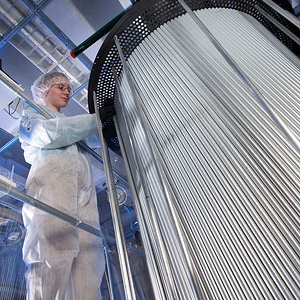
Maddi Brumbaugh (S 2013)
Physics major, International Relations and Politics major, particle detector builder
Bio
Constructing a state-of-the-art particle detector
Maddison “Maddi” Brumbaugh (S’13) is a self-proclaimed sci-fi nerd. As a girl, she devoured Isaac Asimov’s books and was captivated by the romance of outer space and the promise of astronomy. So when she came to Carnegie Mellon, she signed on as an astrophysics major. And then one class changed everything.
It was Electronics, taught by Physics Professor Curtis Meyer, and Brumbaugh had an epiphany.
“You got to build circuits. And splice things. It was so fun,” she said. “I’m still interested in astronomy, but when you find something you’re good at and enjoy, you want to stick with it a little more.”
Now a junior Applied Physics major (with an additional major in International Relations and Politics), Brumbaugh may not be exploring the mysteries of the universe, but she’s contributing—in a big way—to particle physicists’ efforts to explore the universe’s building blocks, atomic nuclei. Brumbaugh is working with Professor Meyer and his lab team to build a particle detector for the new GlueX experiment at the Thomas Jefferson National Accelerator Facility (JLab) in Newport News, VA.
Most days you can find Brumbaugh behind a nondescript door on the 8th floor of Wean Hall. Inside, there’s a state-of-the-art clean room with a partially constructed detector hanging from the ceiling. Gary Wilkin, who built the clean room and is involved in the detector’s construction, put Brumbaugh through the paces when she joined the lab in the summer in 2011.
“I’d never been in a clean room before. There are a lot of rules. Never touch anything without gloves on. Never touch your face when you have gloves on because you don’t want to get oils on your gloves and then touch the detector. It’s so hard to avoid scratching your face when you know you can’t,” she joked.
Together with technicians Amy Woodhall and Kaitlin Mueller, Brumbaugh is helping to outfit the detector with 3,522 “straws,” long skinny plastic pipes lined with aluminum that is connected to an electrical ground. Each straw envelops a 20-micron thick wire—five times smaller than the width of a human hair. These wires will detect particles generated when electrons accelerated by 12 billion electron volts smash into atoms at the JLab facility. To gather accurate data, each wire, plus the straws protecting it, has to be perfect. That’s a lot of pressure for an undergraduate who is still learning to master key skills, like soldering. But she is up to the task.
“It’s pressure that feels good. When you do it right, it’s cool. But it makes it even worse when you mess up.”
So far, her experience at Carnegie Mellon has exceeded her expectations. From the first moment she stepped on campus as a high school student to take part in a pre-college program, she knew that she would love it here.
“It was so comfortable. Everyone is really nerdy and it’s OK. It’s cool to be nerdy here, and that’s awesome.”
Brumbaugh’s nerd factor may be high, but it’s tempered by having some serious hands-on skills. How many 19-year-olds do you know who can solder precision electronics for a state-of-the-art particle detector? Oh wait, that might make her even nerdier. But she’s cool with that.
This story originally appeared in Science Connection.